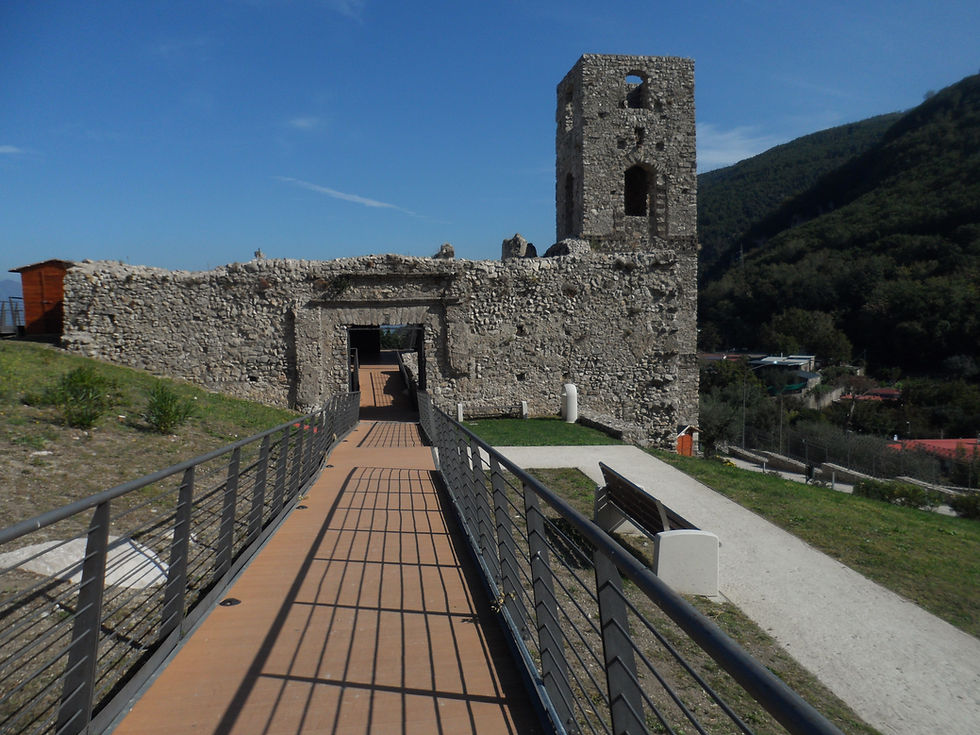The Castle of Lettere: the Middle Ages accessible
- Angelo e Adele
- Oct 26, 2019
- 3 min read
Updated: Dec 30, 2022
After the Quisisana Palace and the Faito cableway, we continue with our little big discoveries in the field of accessible tourism in Campania, in the Stabia area in particular. This time we went to Lettere, a town in the province of Naples adjacent to Gragnano; on the hill of San Nicola del Vaglia, 340 meters above sea level, we visited the Castle of Lettere (*) (Via San Nicola, Lettere), a monumental complex whose description we take from the site of the Archaeological Park of Pompeii (http://pompeiisites.org/lettere), which takes care of their protection: The Castle of Lettere was built by the Duchy of Amalfi during the 10th century to defend its northern borders and was part of a network of fortifications that ensured the Amalfi people control of the two sides of the Lattari mountains. The site, in fact, still enjoys a splendid panoramic position that allowed you to control the area from the port of Castellammare to the mouth of the Sarno and the entire Gulf of Naples, but also the Sarno Valley dominated by Vesuvius and the Sarno mountains up to in Pagani. Since its foundation, the castle had the shape of a fortified village with multi-storey houses, as documents from 1030 and 1033 tell us. The construction of the fortress, what we now call a castle, is probably connected to the settlement of a feudal lord. who built it as a place of residence within the walls and a symbol of his power. The building has a trapezoidal shape and retains four towers, the highest of which functions as a keep. Inside the walls, a cathedral was also built, which has been the seat of a bishopric since 987. The beautiful bell tower decorated with inlays in gray tuff and yellow sandstone forming stars, crosses and lozenges was attached to this first building in the 12th century.
To add only that, after having passed through all the dynasties that dominated the Kingdom of Naples in the Middle Ages (Normans, Swabians, Angevins, Aragonese), the Castle lost all its military and residential functions, until it was reduced to a ruin; only between the end of the 1900s and the early years of the 2000s was a restoration carried out together with a campaign of excavations which revealed various structures connected to the fortress. All this is part of a project, financed with European funds, with an agreement between the Campania Region and the Municipality of Lettere (http://www.comune.lettere.na.it/zf/index.php/musei-monumenti/index/dettaglio-museo/museo/1), a project aimed at improving the usability of the complex, in the direction of creating a real Archaeological Park of Lettere. This effort has led, among other things, to a significant removal of architectural barriers through the massive use of walkways that allow the physically disabled to view almost the entire complex. As we will see from the photos, the walkways have been built with slopes that can be faced both with electric wheelchairs but also with hand-pushed chairs:











You may have noticed the wooden pavilions scattered throughout the castle; this brings us to a next initiative that goes in the direction of enhancing the site. We are talking about Christmas at the Castello di Lettere, in which from November 9th to December 26th there will be the Christmas markets, with tasting of the Novello di Lettere wine and other typical products (https://www.facebook.com/natalealcastellodilettere). It should be noted that the Penisola Sorrentina DOC sparkling red wine Lettere is one of the types of wine provided for by the denomination Penisola Sorrentina DOC, a DOC of the Campania region. The markets can be an opportunity to visit the complex in the evening; otherwise we recommend that you go and discover it early in the morning and then continue the visit with the excavations of Pompeii or Herculaneum, or go to Sorrento. We refer to our posts on these locations, with related recommendations on accessible restaurants. (*) symbol indicating the presence of toilets equipped for the disabled

Comments